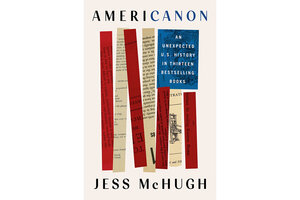The popular books that brought Americans together in a common culture
The canon of popular American literature not only unified the culture, it helped create the national narrative of individualism and self-reliance.

The United States’ messy experiment in democracy is best understood not through the country’s highbrow literature or its founding documents, but through popular books that its inhabitants have read and consulted repeatedly. This is the argument put forward by historian Jess McHugh in her delightful debut, “Americanon: An Unexpected U.S. History in Thirteen Bestselling Books.”
The 13 books include: Noah Webster’s dictionary; “The Old Farmer’s Almanac”; “The Autobiography of Benjamin Franklin”; Emily Post’s “Etiquette: In Society, in Business, in Politics and at Home”; Dale Carnegie’s “How to Win Friends and Influence People”; “Betty Crocker’s Picture Cook Book”; and several others. These books, she contends, helped create a shared culture in a sprawling country whose citizens lacked a common heritage.
For example, at a time when most Americans felt that spelling and grammar should adhere to British usage rules, famed lexicographer Noah Webster aspired to popularize a standardized form of American English. He believed that cultural independence from Britain was just as important as political independence. He laid out his vision for that new form in his 1783 speller, as well as in the colossal dictionary – first published in 1828 – that is the forebear to today’s Merriam-Webster.
Webster aimed not only to free American English from British norms – for instance, by eliminating the “u” in “colour” – but to harmonize the language of a regionally diverse young nation. “Education was the basis of national sentiment, and national sentiment was required for American survival, according to Webster,” McHugh observes.
Just as an ostensibly objective reference book like Webster’s dictionary had a patriotic agenda, many of the titles McHugh covers were doing cultural or political work beneath the surface. “The Old Farmer’s Almanac” includes practical information on planting seasons and weather patterns in addition to recipes and more whimsical content. But in its early years, the almanac – which has been continuously published since 1792 – also ennobled the independent yeoman farmer. He was depicted in its pages, in the author’s words, “as self-sufficient, smart but not overly educated, patriotic, and civically engaged – all elements that would become foundations of the ideal early American.”
The early “Almanac” also featured civic information, including court dates and names of congressmen. In doing so, McHugh writes, it “started to weave a tradition of democracy into daily life for average Americans, physically tying together their farming cycles and the cycles of their government.”
McHugh observes that many of the books in “Americanon” repressed dark truths about the American experience. Emily Post’s 1922 tome on proper etiquette seemed to suggest that America was a meritocratic country without an aristocracy in which social mobility could be achieved simply by mastering a set of behavioral rules. But much remained unsaid in Post’s manual when it came to race and class. Calling American rules of manners “a cruel trick,” McHugh notes that Post herself attempted to have a woman stricken from the social register when it was discovered that her father was “colored.”
The titles in “Americanon” exalt virtues drawn from the country’s enduring national myths: individualism, self-reliance, thrift, and industry. The book’s chronological structure highlights notable ways in which certain themes have overlapped and evolved over time. In “How to Win Friends and Influence People,” published as the country was emerging from the Great Depression, Carnegie renewed faith in the idea of the self-made man that was popularized in Benjamin Franklin’s rags-to-riches narrative. In Carnegie’s worldview, however, self-promotion was as integral to success as hard work.
And Catharine Beecher’s 1869 handbook “The American Woman’s Home” – which was written with the help of her sister, “Uncle Tom’s Cabin” author Harriet Beecher Stowe – made women and their domestic labor central to the moral health of the nation. The Betty Crocker cookbook, published almost a century later, promoted a similar message, but with a generous helping of consumerism added to the mix.
McHugh’s conclusions can be too pat, and her analysis occasionally lacks rigor. For instance, she writes that “Betty Crocker and General Mills are not single-handedly responsible for the revival of the cult of domesticity in midcentury America.” This is not only obvious, but also calls attention to the fact that the author hasn’t addressed the many other forces in Cold War-era America which told women that their place was in the home.
Still, due in no small part to the appeal of its premise, “Americanon” is an edifying read, one that might lead readers to reconsider their own dog-eared American classics.

